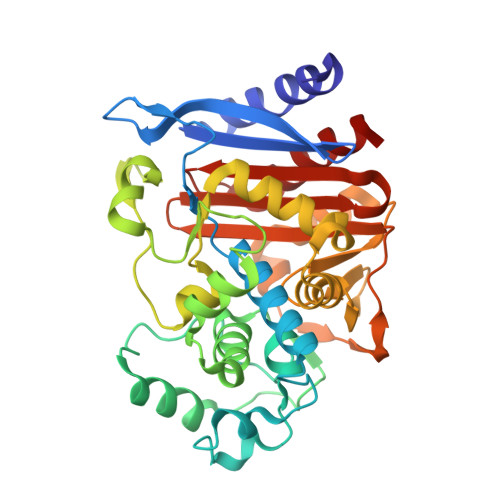Structural Investigations of the Inhibition of Escherichia coli AmpC beta-Lactamase by Diazabicyclooctanes.
Lang, P.A., Leissing, T.M., Page, M.G.P., Schofield, C.J., Brem, J.(2021) Antimicrob Agents Chemother 65
- PubMed: 33199391
- DOI: https://doi.org/10.1128/AAC.02073-20
- Primary Citation of Related Structures:
6T5Y, 6T7L, 6TBW, 6TPM - PubMed Abstract:
¦Â-Lactam antibiotics are presently the most important treatments for infections by pathogenic Escherichia coli , but their use is increasingly compromised by ¦Â-lactamases, including the chromosomally encoded class C AmpC serine-¦Â-lactamases (SBLs). The diazabicyclooctane (DBO) avibactam is a potent AmpC inhibitor; the clinical success of avibactam combined with ceftazidime has stimulated efforts to optimize the DBO core. We report kinetic and structural studies, including four high-resolution crystal structures, concerning inhibition of the AmpC serine-¦Â-lactamase from E. coli (AmpC EC ) by clinically relevant DBO-based inhibitors: avibactam, relebactam, nacubactam, and zidebactam. Kinetic analyses and mass spectrometry-based assays were used to study their mechanisms of AmpC EC inhibition. The results reveal that, under our assay conditions, zidebactam manifests increased potency (apparent inhibition constant [ K iapp ], 0.69?¦ÌM) against AmpC EC compared to that of the other DBOs ( K iapp = 5.0 to 7.4?¦ÌM) due to an ¡«10-fold accelerated carbamoylation rate. However, zidebactam also has an accelerated off-rate, and with sufficient preincubation time, all the DBOs manifest similar potencies. Crystallographic analyses indicate a greater conformational freedom of the AmpC EC -zidebactam carbamoyl complex compared to those for the other DBOs. The results suggest the carbamoyl complex lifetime should be a consideration in development of DBO-based SBL inhibitors for the clinically important class C SBLs.
Organizational Affiliation:
Department of Chemistry, Chemistry Research Laboratory, University of Oxford, Oxford, United Kingdom.




















